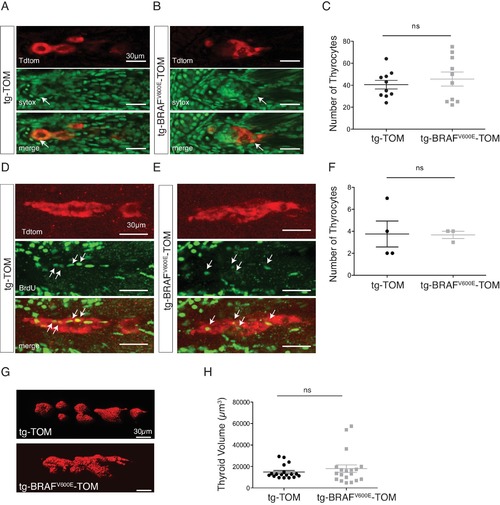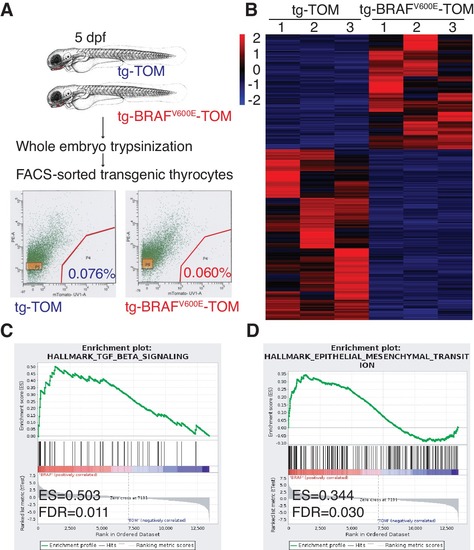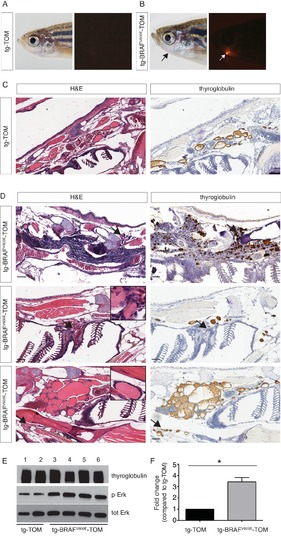- Title
-
Oncogenic BRAF disrupts thyroid morphogenesis and function via Twist expression
- Authors
- Anelli, V., Villefranc, J.A., Chhangawala, S., Martinez-McFaline, R., Riva, E., Nguyen, A., Verma, A., Bareja, R., Chen, Z., Scognamiglio, T., Elemento, O., Houvras, Y.
- Source
- Full text @ Elife
|
BRAFV600E expression in thyrocytes disrupts follicle structure. (A) Schematic diagram of the constructs used to create transgenic lines, containing a specific zebrafish thyroglobulin promoter (zf tg prom) driving expression of either human BRAFV600E or TdTomato fluorophore. (B–C) Brightfield micrographs overlayed on to an epifluorescent micrograph of a live 5 dpf tg-TOM and tg-BRAFV600E-TOM larvae. (D–E) Representative confocal images of 5 dpf fixed tg-TOM and tg-BRAFV600E-TOM larvae immunostained with anti-T4 antibody; white arrows indicate T4-positive follicles. (F) Quantification of the total follicle number in tg-TOM and tg-BRAFV600E-TOM larvae (n = 20). (G) Measurement of follicle diameter in tg-TOM and tg-BRAFV600E-TOM (n = 45 and n = 30, respectively). ***p≤0.001, Student's two-tailed t-test. |
|
Expression of BRAFV600E does not affect proliferation of larval thyrocytes. (A–B) Representative confocal images stacks of 5 dpf fixed transgenic tg-TOM and tg-BRAFV600E-TOM larvae stained with Sytox Green Nucleic Acid Stain; arrows indicate the nuclei of TdTomato-positive cells. (C) Quantification of the total number of thyrocytes (n = 10 for both genotypes). (D–E) Representative confocal images of tg-TOM and tg-BRAFV600E-TOM larvae incubated with BrdU from 3dpf to 5dpf. Immunofluorescence performed with an anti-BrdU antibody, arrows indicate TdTomato-positive BrdU-positive nuclei. (F) Quantification of the TdTomato-positive BrdU-positive thyrocytes (n = 4 and n = 3 for tg-TOM and tg-BRAFV600E-TOM, respectively) (G) Representative images of 5 dpf tg-TOM and tg-BRAFV600E-TOM thyroid obtained using Imaris software. (H) Quantification of the thyroid volume (18040 ± 15199 μm3 and 14841 ± 6422 μm3 for tg-TOM and tg-BRAFV600E-TOM). Ns: not significant, two-tailed Student's t-test. |
|
Combined treatment with BRAF and MEK inhibitors suppresses morphologic effects induced by BRAFV600E in thyrocytes and restores normal follicle structure. (A) Schematic diagram of experimental scheme and treatment conditions of tg-TOM and tg-BRAFV600E-TOM larvae. (B) Epifluorescent live images of tg-TOM and tg-BRAFV600E-TOM larvae treated with either DMSO (vehicle), 2.5 μM dabrafenib, 10 μM selumetinib, or the combination of 2.5 μM dabrafenib and 10 μM selumetinib. (C) Representative confocal images of tg-BRAFV600E-TOM larvae treated with either DMSO (vehicle), 2.5 μM dabrafenib, 10 μM selumetinib, or the combination of 2.5 μM dabrafenib and 10 μM selumetinib and subject to immunofluorescence (IF) using anti-T4 antibody. (D–E) Quantification of thyroid follicle number (D) and follicle diameter (E) in tg-BRAFV600E-TOM larvae after drug treatment compared to vehicle (DMSO) control. The experiment was performed in triplicate. *p≤0.05, **p≤0.01, Student's two-tailed t-test, ns: not significant. |
|
BRAFV600E expression in thyrocytes leads to transcriptional upregulation in genes associated with EMT and TGF-β signaling. (A) Schematic diagram of the FACS-sorting workflow with the experimental plots indicating the percentage of TdTomato-positive cells sorted from tg-TOM and tg-BRAFV600E-TOM. (B) Heat-map depicting top differentially expressed genes (Figure 3—source data 1) in sorted tg-BRAFV600E-TOM compared to tg-TOM. (C,D) Gene set enrichment plots of TGF-β and EMT signatures from RNAseq performed on sorted thyrocytes from tg-BRAFV600E-TOM and tg-TOM larvae (E.S.=0.503, FDR = 0.011, nominal p-val = 0.002 and E.S.=0.344, FDR = 0.035, nominal p-val = 0.0, respectively). |
|
Gene expression changes induced by BRAFV600E in larval thyrocytes. (A) qPCR analysis of select up-regulated genes; data are represented as fold change of tg-BRAFV600E-TOM compared to tg-TOM and are normalized using gapdh as a control. (B) GSEA hallmark gene sets significantly enriched in tg-BRAFV600E-TOM (top 10 signatures, FDR < 25%, nominal p-value<5%). (C) GSEA enrichment plot of ERK signature using RNAseq data generated from sorted zebrafish thyrocytes as described. (D) Heat-map of ERK signature genes (n = 37) differentially expressed in tg-BRAFV600E-TOM sorted thyrocytes compared to tg-TOM. (E) Validation of differential expression of select ERK signature genes using qPCR, data are normalized using gapdh as a control. (F) E-cadherin immunostaining in tg-TOM and tg-BRAFV600E-TOM larvae at 5dpf. EXPRESSION / LABELING:
PHENOTYPE:
|
|
Analysis of a cohort of transgenic zebrafish expressing BRAFV600E in thyrocytes at 5 months post fertilization. (A–B) Photographs and epifluorescent photographs of live five mpf tg-TOM (A) and Tg-BRAFV600E-TOM fish (B) reveals TdTomato-positive tissue. (C) Representative H&E and IHC using anti-thyroglobulin antibody of sagittal section of adult fish tg-TOM at five mpf. (D) Representative images from three tg-BRAFV600E-TOM adult fish at five mpf demonstrating the presence of invasive carcinoma. Top panel, mass of Tg-positive thyroid cells (arrows) invading muscle. Middle panel, thyroid cells invading gill tissue (arrows), inset is 40X. Lower panel, thyroid cells invading subcutaneous fat in the ventral jaw (arrows), inset is 40X. (E) Western blot analysis of thyroid obtained from two tg-TOM (control) and four tumors bearing tg-BRAFV600E-TOM zebrafish. Western blot analysis was performed in duplicate, a representative blot is shown. (F) Quantitative analysis of fold change in pERK/total ERK from (E), p<0.05, Student’s t-test. |
|
Adult transgenic fish expressing BRAFV600E in thyrocytes develop invasive thyroid cancer similar to human PTC. (A–B) Representative H&E and IHC staining using anti-thyroglobulin and anti-P-ERK antibodies performed on sagittal sections from control tg-TOM (A) and tumor bearing tg-BRAFV600E-TOM adult zebrafish at 12 mpf (B) (20X magnification). Arrows indicate sites of carcinoma invading skeletal muscle, inset is 40X magnification of skeletal muscle invasion. (C) High magnification photomicrographs of H&E-stained sections from tg-BRAFV600E-TOM animals. Key diagnostic features of papillary thyroid carcinoma are observed: nuclear grooves (arrows), elongated nuclei (arrows), desmoplastic stromal reaction (asterisk) and crowded nuclei (60X magnification). |
|
Identification of a gene expression signature from adult zebrafish thyroid carcinomas conserved in human patients with thyroid cancer. (A) Schematic diagram of the RNA-seq workflow from adult (12mpf) thyroid tissue. (B) Heat-map depicting the top differentially expressed genes in tg-BRAFV600E-TOM thyroid tissue compared to tg-TOM thyroid tissue (Figure 6—source data 1). (C) GSEA hallmark gene sets significantly enriched in tg-BRAFV600E-TOM. (D) Volcano plot depicting differentially expressed genes in tg-BRAFV600E-TOM compared to tg-TOM thyroid tissue; a set of 58 genes (blue, FDR ≤ 1 × 10−6, FC ≤1.5, (Figure 6—source data 2) was defined as a signature of BRAFV600E expression in thyroid carcinoma. (E) Kaplan-Meier analysis of disease free survival in 496 patients with papillary thyroid cancer stratified by median BRAFV600E gene expression signature identified in (D). |
|
Twist expression is required for BRAFV600E mediated thyroid follicle disruption. (A) Results from an in silico screen of transcription factor (n = 1665) expression in human PTC correlated with BRAFV600E gene signature performed by GSEA. Top hits represented in red. (B) CrisprVariants analysis of twist3 gene editing in zebrafish embryos. tg-BRAFV600E-TOM embryos were microinjected with rCas9 and either a non-targeting sgRNA or a twist3-specific sgRNA. Individual embryos were isolated and a clonal analysis of the twist3 target locus was performed. Non-targeting embryos (n = 5, grouped) had no evidence of deletions at the twist3 locus, 21/21 clones were wild-type. Twist3 targeted embryos (n = 5, one per column) had a range of small indels at the targeting site. (C) Representative confocal images of 5 dpf fixed tg-BRAFV600E-TOM embryo injected with either non-targeting or twist3 targeting sgRNA. Anti-T4 immunostaining performed to identify T4-positive (green) follicles. (D) Quantification of follicle rescue in embryos injected with a non-targeting versus twist3 targeting sgRNA in BRAFV600E-TOM embryos. Follicle rescue was observed in 0/142 non-targeting sgRNA injected embryos vs. 57/173 (32.9%) of twist3 sgRNA injected embryos, p<1.0 × 10−3, two-tailed Fisher exact test. (E) FACS plot of TdTomato-positive cells isolated from twist3 sgRNA injected tg-BRAFV600E-TOM embryos. (F) Alignment of DNA chromatogram from a clone isolated from twist3 sgRNA injected TOM+ cells harboring a three nucleotide deletion in the twist3 gene. The twist3 sgRNA sequence is underlined in red. |
|
Validation of gene editing in thyrocytes and identification of a BRAFV600E gene signature. (A) Volcano plot depicting differentially expressed genes in tg-BRAFV600E-TOM compared to tg-TOM sorted thyrocytes from larvae. Genes significantly upregulated in BRAFV600E thyrocytes are highlighted in blue (n = 85 genes, FDR ≤ 0.01; FC ≥ 1.5, Figure 7—source data 1). (B) T7 mutagenesis assay at the CRISPR target site in the twist3 gene. The assay was performed on genomic DNA from 1dpf embryos injected with either non-targeting sgRNA or twist3 targeting sgRNA and rCas9. Cleavage bands indicate cleavage of hetero-duplex DNA consistent with the presence of mutations at the target site. (C) Photograph of representative 5dpf embryos injected with either non-targeting sgRNA or twist3 sgRNA and rCas9. No significant morphologic defects are noted. |










